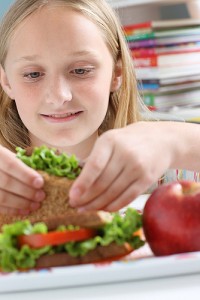
If you’ve ever shopped at a high-end gourmet grocery store, you may have noticed the differences in lighting. Dimly lit in some sections while special lights are focused on products they want you to buy. The food industry has been doing this kind of subtle marketing for years. But what if this same principle was used in a school cafeteria?
“I started wondering a few years ago how I could use common marketing tools to improve public health,” says David Glenn, a doctoral student at the UConn School of Medicine who previously worked as a marketing researcher for food companies. “For instance, how can we use attractive lighting to make vegetables look more appetizing so that kids are more likely to choose them?”
Glenn, a father of two adolescents, noticed their middle school’s cafeteria food line was constructed of stainless steel and dimly lit. It was designed to make it easier to clean, not to make the food more appealing.
“Compare that to a Whole Foods, where it reminds you of a restaurant when you walk in, full of appetizing foods and smells,” says Glenn. “Middle schools aren’t typically like that, they’re antiseptic. But if we could do something subtle such as enhance the lighting on certain foods, maybe we could nudge the students to make healthier choices.”
Glenn knows how effective some of these simple strategies can be. Food stores have found if you increase the size of a shopping cart by 20 percent, the consumer will likely buy 15 percent more. Tantalizing smells and special lighting can also prompt customers to purchase more food.
“There are so many things that retailers and food manufacturers know, that researchers in academia and public health don’t know,” says Ann Ferris, director of the Center for Public Health and Health Policy. “Behavioral economics is now a popular area of research but it’s basically marketing and it’s been going on for a long time.”
But food and marketing companies aren’t known to write journal articles or publish academic papers. That’s why Glenn and Ferris have embarked on this study – to determine whether preferential lighting can influence food choice – even among finicky adolescents – and make an impact in the growing number of overweight kids. They’ve been awarded a $30,000 grant from the U.S. Department of Agriculture’s economic research service to conduct the pilot study.
Ferris says one reason they chose to focus on lighting is because it would be relatively simple and inexpensive for schools to implement. In many instances, the lighting fixtures are already in place so the school would just need to change the light bulbs.
“If the cost of special lighting that makes food look more appetizing is about the same as standard lighting, then why can’t we shine the specialized light on the salads, on the hot vegetables, on the fruit cups?” asks Glenn.
The four-month-long study will involve 20 schools which are similar in population and socioeconomic status. Half will receive the new lighting and half will stay the same. Every week they will track the sales of different foods, healthful and not so healthful, and see what the effects are based on actual behavior.
Glenn says the students and cafeteria workers won’t know they are part of a study. “We won’t need to interview anyone. We’ll just look to see what happens behaviorally. At the end of the study we’ll have real data. We’ll know if X percent of the time we moved more salads with the specialized lighting versus the standard lighting.”
Middle schools were chosen for the lighting study because the students are making real food choices for the first time. In the elementary schools there’s often a cafeteria worker dishing out the food and by the time students reach high school, they may have already formed their food habits.
“We really wanted to aim at the early adolescents to see if we could influence their choices toward more healthful foods,” explains Glenn. “We don’t have anything against the food that is already there, the pizza and the cheeseburgers, we’re just trying to shine a clearer light on more healthful choices.”


